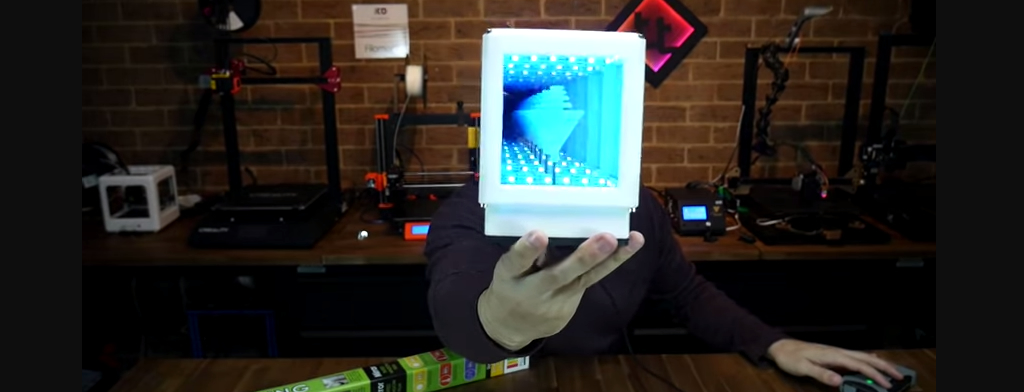When combined, 3D printing technology and the Arduino platform can be used to concoct some amazing devices and objects. Supported by a wide-reaching open-source community, Arduino hardware and software is consistently used as the basis for an endless array of advanced 3D printing projects.
One of the most striking examples that showcase what happens when these two worlds collide is the RGB Infinity Cube, an Arduino-powered reflective box created by Australian designer and maker named Michael Laws.
Recently shared on his popular YouTube channel Teaching Tech, the maker uploaded a video detailing an Arduino RGB NeoPixel-based project called the Infinity Cube. Inside of this 3D printed box, you can place a logo or symbol of your choice, as the box gives it an endless effect using reflective film.
This 3D printed Inifinty Cube is essentially a six-sided version of an infinity mirror, which uses 2-way mirror film to reflect light and generates an effect of boundless repetition of whatever object is propped up inside of the box.
It’s a slightly difficult project that consists of multiple steps and requires a handful of non-printed components. Thankfully, Laws walks us through each step, including printing, wiring, programming, and assembly.
Let’s take a closer look at what you need and how to build your very own 3D printed RGB Infinity Cube.
What You Need & How to Build it
First and foremost, to build your own Infinity Cube, you’ll need to have a 3D printer handy. The STL files for the frame are available to download via Thingiverse, consisting of five different parts. The posts need to be printed four times, the end pieces twice, and the remainder of the 3D printed components just once.
According to the creator of the Infinity Cube, the parts should be printed at 10% infill and a 0.2mm layer resolution. No support structures are required, but adding a raft to the 3D printed posts could be helpful.
Aside from the 3D printed sections, you’ll also need to complete the following parts checklist to construct this project:
ELEGOO UNO R3
Adafruit NeoPixel LED Strip
Reflective Mylar Film
Acrylic Sheet
Wiring Kit
Crimping Tool
(8x) M3 x 20mm bolts
(4x) M3 x 16mm bolts

Once you have all of your parts gathered, it’s time to move onto the assembly process. This will require some cutting, wiring, and programming, so keep that in mind if you’re an inexperienced maker. Thankfully, Laws has shared a comprehensive visual assembly guide on YouTube, which can be found below. We’ll also provide a brief recap to show you what you’ll be going up against.
After 3D printing the various parts, you need to prepare the acrylic by cutting six identical squares that are about 100 x 100mm. The two-way mirror film will then be applied to the acrylic, a step that even Laws struggled with at first, but he eventually found a video from someone with more experience in the matter.
The Teaching Tech host then proceeds to demonstrate how the NeoPixels are wired and mounted inside the top and bottom of the 3D printed end pieces. Check out the video to get a more in-depth explanation on how the Arduino is programmed and used.
Before you can mount the NeoPixel strips inside of the end pieces, the process will require some measuring and testing. Using the 3D printed posts and mirror tiles, proceed to slide each tile into the allotted slots, including one above the LEDs inside of the bottom end piece.
After all of the posts are erected and tiles slid into place, you’ll have to repeat the wiring process for the top end piece as well. In the final segment of the video, the maker tightens all of the screws and shows us how to illuminate the Infinity Cube